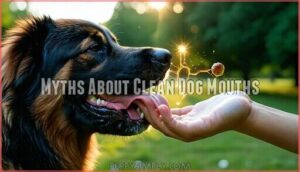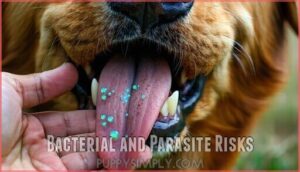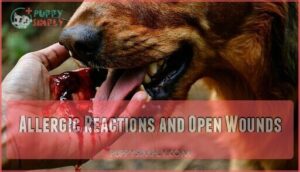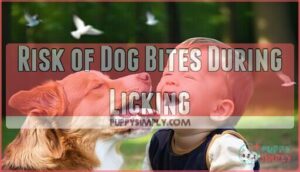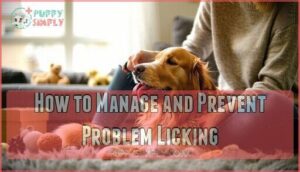This site is supported by our readers. We may earn a commission, at no cost to you, if you purchase through links.

Licking releases oxytocin, strengthening your bond while satisfying their inherited pack instincts from wild ancestors who licked to communicate submission and trigger food sharing.
They’re also drawn to your salty skin, gathering sensory information about your daily activities through taste.
This behavior serves as their universal greeting, expressing affection and peaceful intentions while seeking your attention.
Puppies learn early that licking equals love through maternal care, making it their go-to communication method.
While generally harmless, understanding when licking becomes problematic requires recognizing specific warning signs.
Table Of Contents
- Key Takeaways
- Why Do Dogs Lick You?
- What Does It Mean When Dogs Lick?
- Is Licking a Sign of Affection?
- Can Licking Be a Problem for Dogs?
- Is It Safe to Let Dogs Lick You?
- How to Manage and Prevent Problem Licking
- Frequently Asked Questions (FAQs)
- Why is my dog licking me?
- Why does a dog lick a child?
- Why does my dog lick my face?
- How can excessive licking be distinguished from normal grooming behavior?
- Do all dog breeds lick equally?
- When do puppies start licking behavior?
- Why do dogs lick other dogs?
- Can dogs taste emotions through licking?
- Do male or female dogs lick more?
- Conclusion
Key Takeaways
- Your dog licks you to show affection and strengthen your bond – this behavior releases oxytocin in both of you, creating a natural bonding mechanism inherited from maternal care and pack instincts
- Licking serves as your dog’s primary communication method – they use it to greet you, seek attention, explore your salty taste and scent, and express their emotional state or needs
- While generally harmless, dog licks can pose health risks – their saliva contains bacteria and parasites that can cause infections, especially if you have open wounds or a compromised immune system
- You can manage excessive licking through consistent training – withdraw attention when unwanted licking occurs, reward calm behavior immediately, and provide mental stimulation through puzzle toys or lick mats to redirect the behavior
Why Do Dogs Lick You?
Most dogs lick you because they’re showing affection, seeking attention, or exploring your unique taste and scent.
This natural behavior stems from evolutionary instincts and serves multiple communication purposes in the canine world, which can also be seen as a way of showing attention.
Affection and Bonding
Your dog’s licking behavior stems from deep-rooted social bonds and emotional comfort needs.
This maternal care-inspired action triggers oxytocin release in both you and your pet, strengthening your connection through pack dynamics and canine body language that signals genuine dog affection.
- Mother’s influence: Puppies learn licking equals love through early maternal care
- Chemical connection: Oxytocin release creates natural dog human bond reinforcement
- Pack instincts: Dog social behavior mirrors wild canine greeting rituals
- Love language: These dog love signs demonstrate your pet’s emotional attachment
Understanding common paw licking causes can also provide insight into their overall behavior and health.
Seeking Attention
Ever noticed how your pup becomes a licking machine right when you’re trying to relax?
This classic attention-seeking behavior often stems from boredom relief or loneliness signs.
Dogs quickly learn that licking triggers interaction needs – whether that’s petting, talking, or even gentle pushback.
Your furry friend’s affection craving drives this canine behavior, strengthening the dog human bond through persistent social engagement that rarely goes unnoticed.
Instinctual and Evolutionary Reasons
Your dog’s licking stems from ancient Pack Behavior inherited from Wild Instincts.
This Canine Evolution traces back to wild canids who used Licking Rituals for communication and survival.
Wolves lick pack members’ mouths to trigger food regurgitation, a behavior that’s become a ritualized greeting in domestic dogs.
These Ancestral Traits remain embedded in your pet’s DNA, making licking an instinctual behavior that connects them to their evolutionary roots.
Taste and Sensory Exploration
Your skin becomes a fascinating taste adventure for your dog.
Your skin becomes a fascinating taste adventure for your dog
Salty skin from sweat glands provides irresistible flavor detection opportunities.
With fewer taste buds than humans, dogs rely heavily on sensory exploration through licking for smell investigation.
This scent-driven behavior helps them gather information about your daily activities, and your hands, face, and feet offer concentrated sensory stimulation that satisfies their natural taste preference for investigating their environment, driven by sensory exploration.
Communication and Greeting
Licking serves as a universal greeting-card among dogs, conveying social signals through canine communication.
Your dog’s tongue becomes a messenger, delivering pack behavior messages inherited from wild ancestors.
These greeting rituals mirror wolf interactions, where licking demonstrates submission and peaceful intentions.
When your pup approaches with affection signs, they’re using dog communication signals to say "hello" and establish social bonds.
This natural dog socialization technique helps maintain harmony and shows their understanding of canine affection protocols within your household pack, using dog communication signals.
What Does It Mean When Dogs Lick?
When your dog licks you, they’re sending specific canine communication signals that reveal their emotional state and intentions.
Understanding these dog licking habits helps decode what your furry friend is trying to tell you. Lick frequency varies based on licking triggers like excitement, stress, or sensory exploration needs.
Some dogs use licking as their primary way to communicate hunger, playfulness, or discomfort. Others employ it for emotional support during overwhelming situations.
These dog behavior problems often stem from natural instincts, making why dogs lick a complex blend of biological programming and learned responses to environmental cues.
Dogs may also exhibit excessive licking due to paw health issues, which can be caused by a variety of factors, including injuries, allergies, or parasites, related to their emotional state and environmental cues.
Is Licking a Sign of Affection?
Yes, licking is often a genuine sign of affection that dogs use to express love and strengthen their bond with you.
This behavior releases oxytocin in both dogs and humans, creating a positive feedback loop that reinforces the emotional connection between you and your pet, which can be seen as a sign of love.
Social Bonding and Oxytocin Release
When your dog licks you, they’re triggering powerful bonding mechanisms that strengthen your relationship.
This behavior releases oxytocin in both you and your pet, creating emotional comfort and deepening social attachment.
These affection signals demonstrate genuine canine emotional support, making dog licking habits a natural part of healthy dog socialization techniques that foster intimacy and belonging.
Maternal Licking and Puppyhood Learning
Puppies learn their first lessons about affection through their mother’s gentle tongue.
This maternal care during early development shapes how your dog expresses love as an adult.
Canine instincts rooted in puppy development mean licking becomes their natural language of comfort.
Through maternal behavior and litter behavior, dogs master canine communication that follows them throughout life, which is a key part of their maternal care.
Greeting Rituals and Emotional Comfort
Dogs recognize you as part of their pack through greeting behaviors that mirror wild canine social rituals.
When you return home, their enthusiastic licking demonstrates genuine affection and provides emotional comfort during reunions.
This dog licking behavior serves as canine kisses, reinforcing your bond through familiar scents and taste.
These affection signs reflect deep canine empathy, as dogs often increase licking when sensing your stress or sadness.
Submission and Appeasement Behaviors
When your dog approaches with lowered body posture and gentle licks, they’re demonstrating classic submission behaviors rooted in pack dynamics.
This isn’t about outdated dominance theory, but rather canine etiquette and social hierarchy communication.
Licking serves as calming signals during dog socialization techniques, helping establish peaceful interactions.
Your pup uses canine communication through dog body language to show respect and reduce tension, especially with unfamiliar people or situations.
Understanding dog love bites is also essential in deciphering these subtle cues and affectionate behaviors.
Can Licking Be a Problem for Dogs?
While most dog licking is harmless behavior, it can sometimes signal underlying problems that need attention.
Excessive licking may indicate anxiety, compulsive disorders, medical issues like allergies or infections, or gastrointestinal problems when dogs target inanimate objects, which can also signal underlying problems.
Excessive Licking and Anxiety
Persistent worrying can trigger excessive licking behaviors in your dog.
Anxiety Triggers like loud noises, separation, or environmental changes activate these Stress Behaviors.
Your pup uses excessive licking as natural Lick Therapy, releasing calming endorphins.
While these Calming Signals provide temporary relief, chronic dog anxiety can escalate into Compulsive Licking patterns resembling obsessive-compulsive disorder, requiring professional intervention.
Understanding the reasons behind dog behavior, including excessive licking habits, is essential for effective management and support.
Compulsive Behaviors
Sometimes licking becomes more than just seeking attention—it transforms into compulsive behavior.
When your dog can’t seem to stop licking themselves, you, or objects around them, this repetitive action might signal obsessive-compulsive disorder.
Anxiety triggers and stress signals often fuel these compulsive disorders.
Excessive licking episodes that persist despite distractions typically require behavioral therapy interventions to address underlying compulsive licking patterns effectively.
Medical Issues and Allergies
Excessive licking can signal underlying medical issues and allergies requiring veterinary attention. Skin allergies affect up to 30% of dogs, causing persistent scratching and licking. Food intolerance triggers digestive discomfort that manifests through compulsive licking behaviors.
Common medical conditions causing excessive licking:
- Skin allergies from environmental triggers like pollen or dust mites
- Food intolerance to proteins such as chicken or beef
- Infections in ears, paws, or wounds from constant moisture
- Gastrointestinal disorders including nausea and reflux
- Endocrine disorders like hypothyroidism affecting skin health
Allergic reactions create itchy, inflamed skin that dogs lick for relief, potentially causing secondary infections. Dogs often exhibit dog licking behavior as a way to self-soothe and find comfort.
Licking Inanimate Objects
Many dogs develop fixations on certain objects, surfaces, or fabrics—turning your favorite blanket into their personal licking target.
This compulsive licking behavior often signals underlying anxiety or obsessive-compulsive disorder tendencies.
Surface exploration through persistent licking can indicate gastrointestinal issues, nutritional deficiencies, or boredom.
Object fixation may lead to fabric licking or excessive attention to specific materials, and when licking behavior becomes repetitive and focused on inanimate items, it’s time to consult your veterinarian about potential compulsive behavior patterns.
Is It Safe to Let Dogs Lick You?
While dog licks might seem harmless, they can actually pose several health risks you should consider.
Your dog’s mouth contains bacteria and parasites that can transfer to humans, especially through open wounds or if you have a compromised immune system, which makes you more susceptible to health risks.
Myths About Clean Dog Mouths
The myth surrounding dog mouths being cleaner than human mouths lacks scientific foundation.
While dogs maintain oral hygiene through natural grooming habits, dog saliva contains distinct bacteria that pose health risks.
Their mouths harbor pathogens from eating habits and environmental exposure, making clean teeth don’t guarantee sterile saliva, which in turn makes mouth myths misleading for pet owners considering dog licking behavior, due to the presence of pathogens.
Bacterial and Parasite Risks
Dog saliva harbors harmful bacteria like Capnocytophaga, which causes severe infections in humans through broken skin contact.
While rare, these bacterial infections can lead to sepsis or death, particularly affecting immunocompromised individuals.
Your furry friend’s mouth also carries zoonotic diseases including Salmonella, E. coli, and intestinal parasites like Giardia that transmit through oral contact with contaminated surfaces.
Allergic Reactions and Open Wounds
Your skin’s natural barrier becomes vulnerable when dog saliva meets open wounds or triggers allergic reactions.
Bacteria from their mouths can infiltrate healing tissue, potentially causing serious infections that require veterinary care and proper wound management.
- Skin irritation may develop into painful, inflamed patches that disrupt your daily comfort
- Wound care becomes compromised when bacterial contamination slows natural healing processes
- Allergy symptoms like swelling, redness, or hives can escalate into severe reactions requiring medical attention
- Infection risks multiply dramatically when saliva enters broken skin, creating dangerous health complications
- Healing processes get derailed by constant moisture and bacteria, prolonging recovery time substantially
Dogs may also exhibit behaviors like excessive paw licking habits due to various health issues, which can be a concern for their overall well-being.
Risk of Dog Bites During Licking
Excited dogs sometimes nip during enthusiastic licking sessions, especially around faces and hands.
Children face higher bite risks due to sudden movements that trigger defensive responses.
Watch for signs of dog aggression like stiff body language or resource guarding during attention-seeking behaviors.
Dogs with anxiety or obsessive-compulsive disorder may escalate from licking to biting when overstimulated, making bite prevention essential through proper dog behavior management.
How to Manage and Prevent Problem Licking
While licking is natural behavior, excessive or problematic licking can become disruptive for both you and your dog.
Fortunately, you can use proven training techniques and environmental changes to redirect this behavior effectively.
Denying Attention to Unwanted Licking
When unwanted licking becomes attention-seeking behavior, immediately withdraw your focus.
Turn away, cross your arms, or leave the room without speaking.
This technique, known as attention withdrawal, removes the reward your dog seeks.
Consistently ignore licking episodes while using lick deterrents if necessary.
The key is remaining neutral—no eye contact, verbal responses, or physical interaction until the behavior stops completely.
Using effective dog lick deterrents can also help in managing the behavior.
Positive Reinforcement and Rewarding Calm
You’ll find success when you reward good behavior immediately after your dog stops licking.
This positive reinforcement strengthens calm behavior patterns and reduces attention-seeking tendencies.
Here’s your action plan:
- Praise instantly when licking stops
- Offer treats for gentle interaction
- Give attention only during calm moments
- Use calming signals like slow blinking
- Practice distraction with alternate behaviors
This reward training approach transforms licking into a calming signal.
Providing Enrichment and Distraction
Boredom breeds trouble—idle paws often find mischief.
Providing Mental Stimulation through Environmental Enrichment redirects your dog’s attention-seeking licking behavior toward healthier outlets. Interactive Games and Sensory Toys offer engaging alternatives that satisfy your pet’s natural curiosity.
Strategic distraction prevents problematic licking while promoting overall wellbeing through purposeful Play Activities. Dogs often enjoy dog lick toys as a form of mental stimulation and satisfaction.
| Enrichment Type | Examples | Benefits |
|---|---|---|
| Mental Stimulation | Puzzle feeders, treat-dispensing balls | Reduces boredom, channels energy |
| Sensory Toys | Textured chew toys, snuffle mats | Satisfies exploration instincts |
| Interactive Games | Hide-and-seek, training sessions | Strengthens bond, provides focus |
| Environmental Enrichment | Rotating toys, new walking routes | Prevents habituation, maintains interest |
| Play Activities | Fetch, tug-of-war, agility courses | Physical exercise, mental engagement |
Consulting a Veterinarian for Compulsive Licking
When enrichment strategies don’t resolve persistent licking behaviors, veterinary consultation becomes necessary.
Professional medical diagnosis can identify underlying compulsive disorders or canine anxiety that require specialized treatment. Your veterinarian will assess whether your dog’s licking behavior indicates obsessive-compulsive disorder or other medical conditions.
Signs requiring veterinary advice include:
- Licking that causes hair loss or skin wounds
- Sudden onset of compulsive behavior patterns
- Licking paired with limping or vocalization
- Persistent self-injury through excessive licking
A veterinary behaviorist may recommend medication alongside behavior modification protocols to address licking disorders effectively.
Using Tools Like Dog Lick Mats
Redirecting your dog’s licking impulses through specialized tools can transform problematic behavior into productive activity.
Dog lick mats provide sensory stimulation and calming aids that satisfy their natural grooming habits.
These interactive games offer mental enrichment while promoting behavior modification.
Simply spread treats or wet food on textured surfaces, creating engaging dog toys that redirect excessive licking toward appropriate outlets.
The use of dog lick mats relies on understanding dog calming products to effectively manage licking behaviors.
Frequently Asked Questions (FAQs)
Why is my dog licking me?
Loving licks likely signal affection, attention-seeking, or taste exploration. Your pup’s probably showing love, wanting interaction, or enjoying your skin’s salty flavor from natural oils and sweat glands.
Why does a dog lick a child?
Dogs lick children for the same reasons they lick adults: showing affection, exploring interesting tastes and scents on skin, seeking attention, or expressing comfort and bonding through this natural, instinctive behavior.
Why does my dog lick my face?
Your pup’s face-licking stems from affection and instinct.
They’re showing love, seeking attention, or exploring your scent and taste.
Human skin’s saltiness appeals to them, while licking releases feel-good chemicals in their brain.
How can excessive licking be distinguished from normal grooming behavior?
Excessive licking becomes concerning when it’s persistent, targets one area repeatedly, or occurs without clear triggers.
Normal grooming is occasional and purposeful, while problematic licking is compulsive, frequent, and may indicate underlying anxiety, medical issues, or behavioral problems requiring veterinary attention.
Do all dog breeds lick equally?
No, different breeds don’t lick equally.
Individual personality matters more than breed.
Some breeds like Golden Retrievers and Labs tend to be more affectionate lickers, while others are naturally less demonstrative.
When do puppies start licking behavior?
Newborn puppies begin licking behaviors within their first few days of life.
You’ll notice your puppy naturally licking from maternal interactions, developing this instinctive behavior through nursing and grooming experiences during early development.
Why do dogs lick other dogs?
Canine companions communicate through licking as a natural greeting ritual, showing submission to dominant pack members, and expressing affection. They’re also gathering scent information about their fellow furry friends.
Can dogs taste emotions through licking?
Dogs can’t taste emotions directly, but they may detect chemical changes in your saliva, sweat, and skin oils that reflect your emotional state through their enhanced smell and taste abilities.
Do male or female dogs lick more?
Every dog has their day," but research shows no significant difference between male and female dogs’ licking frequency.
Individual personality, training, and socialization matter more than gender in determining your pup’s affectionate licking habits, as complete concepts like these are crucial for understanding canine behavior.
Conclusion
Like a well-trained compass always pointing north, your dog’s licking behavior consistently points toward their deep emotional connection with you.
Understanding why do dogs lick you helps strengthen your relationship while maintaining appropriate boundaries.
Whether driven by affection, attention-seeking, or instinctual communication, this behavior reflects their natural pack mentality.
By recognizing when licking becomes excessive and implementing consistent training techniques, you’ll create a healthier dynamic.
Remember that professional veterinary guidance guarantees any underlying medical issues are properly addressed for your pet’s wellbeing.
- https://vcahospitals.com/shop/articles/why-do-dogs-lick-humans
- https://thevets.com/resources/pet-health-care/why-do-dogs-lick-you/
- https://www.rearoadanimalhospital.com/the-science-behind-the-slurp-why-dogs-engage-in-excessive-licking/
- https://www.popsci.com/science/why-do-dogs-lick-humans/
- https://www.sciencefocus.com/nature/why-do-dogs-lick-people







